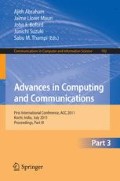Abstract
Chaotic cryptography is slowly emerging as a subfield of cryptography. Many encryption algorithms, secure hash functions and random number generators have been proposed in the literature which are based on well-known chaotic functions. Chaotic keyed hash functions are proposed in the literature but have not been analysed for integrity check value purpose in the literature. We propose a keyed chaotic hash function based on parametrized family of logistic and tent maps and develop a message authentication code (MAC) which outputs a 128 bit message digest(MD).The keyed hash function is designed such that it is resistant to preimage and second preimage attacks. The chaotic hash functions proposed in the literature use a multitude of chaotic maps and we show in this paper that using two chaotic maps judiciously achieves a secure keyed hash function. The proposed keyed hash function is analysed for its sensitivity to the two secret keys that of initial value as well as the parameter value of the family of functions. Experiments in which as the secret keys are infinitesimally changed, the hash value obtained is shown to have nearly 50% of the bits different from the original MD. Further similar experiments are repeated with MD truncated to the first 96 bits, which is the default length for authentication data field in IPSec authentication header and encapsulating security payload. Once again the confusion is shown to be very close to 50%.
Access this chapter
Tax calculation will be finalised at checkout
Purchases are for personal use only
Preview
Unable to display preview. Download preview PDF.
References
Buchmann, J.A.: Introduction to Cryptography, pp. 247–248. Springer, Heidelberg (2001)
Stinson, D.R.: Cryptography: Theory and Practice. CRC Press, Boca Raton (1995)
Stallings, W.: Cryptography and Network Security, Principles and Practice, pp. 493–500. Pearson, London (2004)
Wang, X., Yu, H.: How to break MD5 and other hash functions. In: Cramer, R. (ed.) EUROCRYPT 2005. LNCS, vol. 3494, pp. 19–35. Springer, Heidelberg (2005)
Wang, X., Yin, Y.L., Yu, H.: Finding collisions in the full SHA-1. In: Shoup, V. (ed.) CRYPTO 2005. LNCS, vol. 3621, pp. 17–36. Springer, Heidelberg (2005)
Baptista, M.S.: Chaos in cryptography. Phys. Lett. A 240, 50–54 (1998)
Taylor, R.: An integrity check value algorithm for stream ciphers. In: Stinson, D.R. (ed.) CRYPTO 1993. LNCS, vol. 773, pp. 40–48. Springer, Heidelberg (1994)
Jhansi Rani, P., Sambasiva Rao, M., Durga Bhavani, S.: Design of secure chaotic hash function based on logistic and tent Maps. In: Accepted for Publication in the Proceedings of CNSA-2011. Springer, Heidelberg (2011)
Delfs, H., Knebl, H.: Introdution of Cryptography. Springer, Heidelberg (2002)
Jiashu, Zhang, Wang, X., Zhang, W.: Chaotic keyed hash function based on feedforward-feedback nonlinear digital filter. Physics Letters A 362, 439–448 (2007)
Xiao, D., Liao, X., Wang, Y.: Parallel keyed hash function construction based on chaotic neural network. Neurocomputing 72, 2288–2296 (2009)
Xiao, D., Liao, X.F., Deng, S.J.: One-way hash function construction based on the chaotic map with changeable parameter. Chaos, Solitons & Fractals 24, 65–71 (2005)
Yi, X.: Hash function based on chaotic tent maps. IEEE Transactions on Circuits and Systems-II 52, 354–357 (2005)
Author information
Authors and Affiliations
Editor information
Editors and Affiliations
Rights and permissions
Copyright information
© 2011 Springer-Verlag Berlin Heidelberg
About this paper
Cite this paper
Rani, P.J., Durga Bhavani, S. (2011). Chaotic Integrity Check Value. In: Abraham, A., Mauri, J.L., Buford, J.F., Suzuki, J., Thampi, S.M. (eds) Advances in Computing and Communications. ACC 2011. Communications in Computer and Information Science, vol 192. Springer, Berlin, Heidelberg. https://doi.org/10.1007/978-3-642-22720-2_1
Download citation
DOI: https://doi.org/10.1007/978-3-642-22720-2_1
Publisher Name: Springer, Berlin, Heidelberg
Print ISBN: 978-3-642-22719-6
Online ISBN: 978-3-642-22720-2
eBook Packages: Computer ScienceComputer Science (R0)

